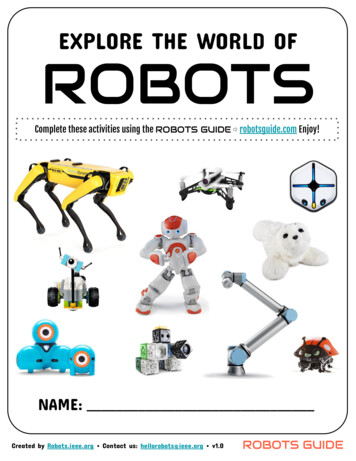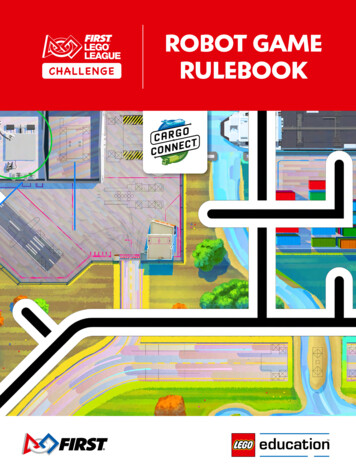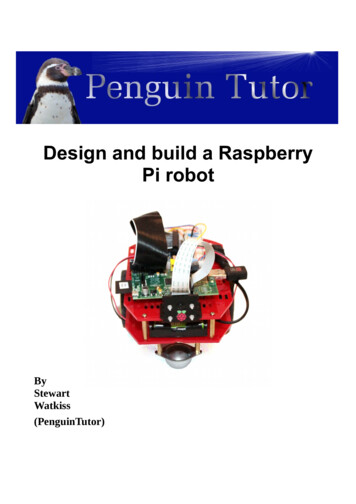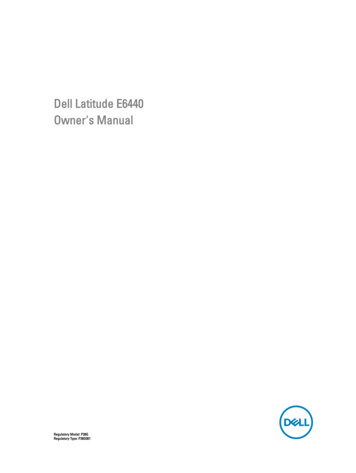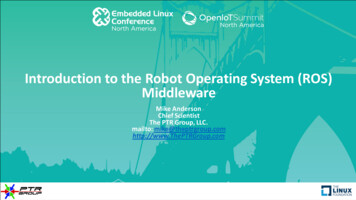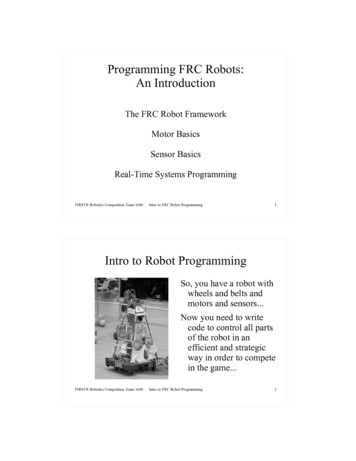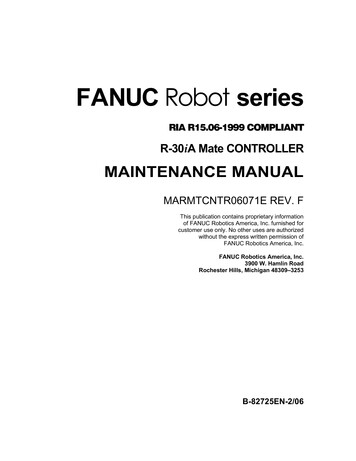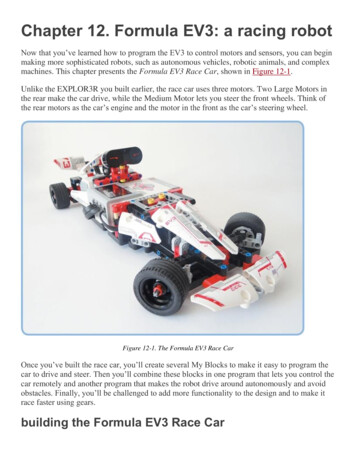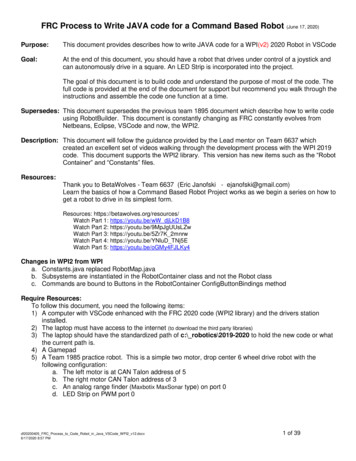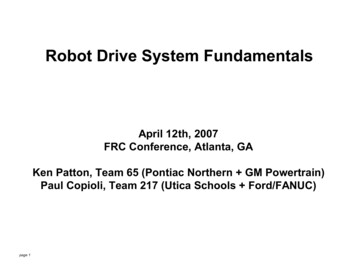
Transcription
FIRST Drive Systems 4/12/2007Copioli & PattonRobot Drive System FundamentalsApril 12th, 2007FRC Conference, Atlanta, GAKen Patton, Team 65 (Pontiac Northern GM Powertrain)Paul Copioli, Team 217 (Utica Schools Ford/FANUC)page 1
FIRST Drive Systems 4/12/2007Copioli & PattonRobot Drive Systems1. Drive System Requirements2. Traction Fundamentals3. FIRST Motors4. Gearing Fundamentals5. System Design Condition6. Practical Considerationspage 2
FIRST Drive Systems 4/12/2007Copioli & PattonDrive System Requirements(Know what you want it to do!)Before you start designing your machine, you must knowwhat you want it to doThe game rules and your team’s chosen strategy will helpyou decide what you want it to doBy spending some time and deciding for sure what youwant it to do, you will be able to make good decisionsabout what design to chooseThis needs to be a team effortpage 3
FIRST Drive Systems 4/12/2007Copioli & PattonSome Features That Help ProvideGood Drive System AttributesAttributeGood Features to Havehigh top speedhigh power, low losses, the right gear ratioaccelerationhigh power, low inertia, low mass, the right gear ratioTRACTION pushing/pulling ability high power, high traction, the right gear ratio, low lossespage 4maneuverabilitygood turning methodaccuracygood control calibration, the right gear ratioobstacle handlingground clearance, obstacle "protection," drive wheels on floorclimbing abilityhigh traction, the right gear ratio, ground clearancereliability/durabilitysimple, robust designs, good fastening systemsease of controlintuitive control method, high reliability
FIRST Drive Systems 4/12/2007Copioli & PattonSome Features That Help ProvideGood Drive System AttributesAttributeGood Features to Havehigh top speedhigh power, low losses, the right gear ratioaccelerationhigh power, low inertia, low mass, the right gear ratioGEARINGpushing/pulling ability high power, high traction, the right gear ratio, low lossespage 5maneuverabilitygood turning methodaccuracygood control calibration, the right gear ratioobstacle handlingground clearance, obstacle "protection," drive wheels on floorclimbing abilityhigh traction, the right gear ratio, ground clearancereliability/durabilitysimple, robust designs, good fastening systemsease of controlintuitive control method, high reliability
FIRST Drive Systems 4/12/2007Copioli & PattonRobot Drive Systems1. Drive System Requirements2. Traction Fundamentals3. FIRST Motors4. Gearing Fundamentals5. System Design Condition6. Practical Considerationspage 6
Traction rning thewheelmaximumtractiveforce FIRST Drive Systems 4/12/2007Copioli & e friction coefficient for any given contact with the floor, multiplied bythe normal force, equals the maximum tractive force can be applied atthe contact area.Tractive force is important! It’s what moves the robot.page 7
Traction FundamentalsThe Basic Equations Ffriction * Fnormal Experimentally determine : Fnormal Weight * cos( ) Fparallel Weight * sin( )FIRST Drive Systems 4/12/2007Copioli & PattonnoitcFfrilellarapFFfriction * Weight * cos( )Fparallel Weight * sin( ) * Weight * cos( ) sin( ) / cos( )page 8 tan( )alWhen Ffriction Fparallel, no slipormFn Weight
Traction Fundamentals“Friction Coefficient”Friction coefficient is dependent on:Materials of the robot wheels (or belts)Shape of the robot wheels (or belts)Material of the floor surfaceSurface conditionspage 9FIRST Drive Systems 4/12/2007Copioli & Patton
Traction FundamentalsWheel MaterialsFriction coefficient is dependent on:Materials of the robot wheels (or belts)Shape of the robot wheels (or belts)Material of the floor surfaceSurface conditionsFIRST Drive Systems 4/12/2007Copioli & PattonHigh Friction Coeff:soft materials“spongy” materials“sticky” materialsLow Friction Coeff:hard materialssmooth materialsshiny materialsIt is often the case that “good” materials wear out muchfaster than “bad” materials - don’t pick a material that isTOO good!Advice: make sure you have tried & true LEGAL materialpage 10
FIRST Drive Systems 4/12/2007Copioli & PattonTraction FundamentalsShape of Wheels (or Belts)Materials of the robot wheels (or belts)Want the wheel (or belt)surface to “interlock”with the floor surfaceShape of the robot wheels (or belts)On a large scale:Friction coefficient is dependent on:Material of the floor surfaceSurface conditionsAnd on a small scale:(see previous slide)page 11
FIRST Drive Systems 4/12/2007Copioli & Pattonfor breaking the rulespage 12
FIRST Drive Systems 4/12/2007Copioli & PattonTraction FundamentalsMaterial of Floor SurfaceFriction coefficient is dependent on:Materials of the robot wheels (or belts)Shape of the robot wheels (or belts)Material of the floor surfaceSurface conditionspage 13This is not up to you!Know what surfaces (allof them) that you will berunning on.
Traction FundamentalsSurface ConditionsFriction coefficient is dependent on:Materials of the robot wheels (or belts)Shape of the robot wheels (or belts)Material of the floor surfaceSurface conditionsFIRST Drive Systems 4/12/2007Copioli & PattonIn some cases thiswill be up to you.Good:clean surfaces“tacky” surfacesBad:dirty surfacesoily surfacesDon’t be too dependent on the surface condition,since you cannot always control it. But don’tforget to clean your wheels.page 14
Traction Fundamentals“Normal Force”weightnormalforce(rear)FIRST Drive Systems 4/12/2007Copioli & Pattonfrontnormalforce(front)The normal force is the force that the wheels exert on the floor, and isequal and opposite to the force the floor exerts on the wheels. In thesimplest case, this is dependent on the weight of the robot. The normalforce is divided among the robot features in contact with the ground.page 15
Traction Fundamentals“WeightDistribution”more weight in backdue to battery andmotorsEXAMPLON L Y EFIRST Drive Systems 4/12/2007Copioli & Pattonless weight in frontdue to fewer partsin this areafrontmorenormalforcelessnormalforceThe weight of the robot is not equally distributed among all the contactswith the floor. Weight distribution is dependent on where the parts arein the robot. This affects the normal force at each wheel.page 16
FIRST Drive Systems 4/12/2007Copioli & PattonTraction FundamentalsWeight Distribution is Not Constantarm position inrear makes the weightshift to the reararm position in frontmakes the weightshift to the frontEXAMPLON L Y Efrontnormalforce(rear)page 17normalforce(front)
"Enhanced" Tractionpage 18FIRST Drive Systems 4/12/2007Copioli & Patton
Traction Fundamentals“Weight Transfer”robot acceleratingfrom 0 mph to6 mphEXAMPLON L Y Emore normal force is exertedon the rear wheels becauseinertial forces tend to rotatethe robot toward the rearFIRST Drive Systems 4/12/2007Copioli & Pattoninertial forcesexerted bycomponentson the robotless normal force is exertedon the front wheels becauseinertial forces tend to rotatethe robot away from the frontIn an extreme case (with rear wheel drive), you pull a wheelieIn a really extreme case (with rear wheel drive), you tip over!page 19
FIRST Drive Systems 4/12/2007Copioli & PattonTraction FundamentalsConsider “Transient” Conditionstransient changing with timeWhat happens when the robot bumps into something?What happens when the robot picks up an object?What happens when the robot accelerates hard?What things can cause the robot to lose traction?page 20
FIRST Drive Systems 4/12/2007Copioli & PattonTraction FundamentalsNumber & Location of Drive Wheelsmany variations, and there is no “right” answersimplerear wheel drivetracked drivesimplefront wheel drivesimpleall wheel drivesimplecenter drive6 wheeldriveDrive elements can:steer (to enable turning or “crabbing”)move up and down (to engage/disengage,or to enable climbing)** Can combine some of these features together **Advice: Don’t make it more complex than it has to be!page 21
FIRST Drive Systems 4/12/2007Copioli & PattonRobot Drive Systems1. Drive System Requirements2. Traction Fundamentals3. FIRST Motors4. Gearing Fundamentals5. System Design Condition6. Practical Considerationspage 22
FIRST Drive Systems 4/12/2007Copioli & PattonFIRST Motors1. Motor Characteristics (Motor Curve)2. Max Power vs. Power at 40 Amps3. Motor Comparisons4. Combining Motorspage 23
FIRST Drive Systems 4/12/2007Copioli & Patton Torque v Speed Curves––––Stall Torque (T0)Stall Current (A0)Free Speed ( f)Free Current (Af)Torque, CurrentMotor CharacteristicsT0A0AfSpeedpage 24K (slope) f
FIRST Drive Systems 4/12/2007Copioli & Patton Y Motor Torquem K (discuss later)X Motor Speedb Stall Torque (T0)Torque, CurrentSlope-Intercept (Y mX b)T0K (slope)A0AfSpeed fWhat is K? It is the slope of the line.Slope change in Y / change in X (0 - T0)/( f-0) -T0/ fK Slope -T0/ fpage 25
FIRST Drive Systems 4/12/2007Copioli & Patton Y Motor Torquem K -T0/ fX Motor Speedb Stall Torque T0Torque, Current(Y mX b) Continued .T0 (b)K (-T0/ f)A0AfSpeedEquation for a motor:Torque (-T0/ f) * Speed T0page 26 f
FIRST Drive Systems 4/12/2007Copioli & Patton What are cutoff Amps?– Max useable amps– Limited by breakers– Need to make assumptionsTorque, CurrentCurrent (Amps) and FIRSTT0A0CutoffAmpsAfSpeedCan our Motors operate above 40 amps? f- Absolutely, but not continuous.When designing, you want to be able to perform continuously;so finding motor info at 40 amps could prove to be useful.page 27
FIRST Drive Systems 4/12/2007Copioli & Patton T40 Torque at 40 Amps 40 Speed at 40 AmpsCurrent Equation:Current (Af-A0)/ f * Speed A0Motor Equation:Torque (-T0/ f) * Speed T0page 28Torque, CurrentTorque at Amp LimitT0A0CutoffAmpsAfSpeed f
FIRST Drive Systems 4/12/2007Copioli & PattonPower Torque * SpeedMust give up torque for speedMax Power occurs when:T T0/2 & f/2What if max power occurs ata current higher than 40A?Torque, CurrentPower - Max vs. 40 AmpsPowerT0A0AfSpeed fPaul’s Tip #1: Design drive motor max power for 40A!Power is Absolute - It determines the Torque Speed tradeoff!page 29
FIRST Drive Systems 4/12/2007Copioli & PattonMotor ComparisonsLet’s Look at Some FIRST Motors Chiaphua Motor Fisher-Price MotorWe will compare T0, f, A0, Af, T40, 40, max power(Pmax), amps @ max power (Apmax), and power at40 amps (P40).page 30
FIRST Drive Systems 4/12/2007Copioli & PattonMotor ComparisonsMotorCIMMabuchi 1481.5403.40.1817,500322.5Motor Equations:1. 2006 Fisher-Price: T (-0.64/24,000) * 0.642. 2002-07 Chiaphua: T (-2.45/5,342) * 2.45page 31
FIRST Drive Systems 4/12/2007Copioli & PattonCombining MotorsUsing multiple motors is common for drive trains. We will lookat matching the CIM and the Fisher-Price.I try to match at free speed, but you can match at any speedyou like!! f FP / f Chiaphua 24,000/5342 9/2 Gear RatioWe will use an efficiency of 95% for the match gears.More to come on Gear Ratio & Efficiency a little later!page 32
FIRST Drive Systems 4/12/2007Copioli & PattonCombined Motor DataT0WfPmaxT40W40P40N-mRPMWattsN-mRPMWattsF-P & CIM5.195,3377251.73,642648CIM & CIM4.95,3426851.63,647611CIM, CIM, & F-P7.645,33910682.633,6441004MotorMotor Equations:1. F-P & CIM:T (-5.19/5,337) * 5.192. CIM & CIM:T (-4.9/5,342) * 4.93. CIM, CIM, & F-P: T (-7.64/5,339) * 7.64page 33
FIRST Drive Systems 4/12/2007Copioli & PattonRobot Drive Systems1. Drive System Requirements2. Traction Fundamentals3. FIRST Motors4. Gearing Fundamentals5. System Design Condition6. Practical Considerationspage 34
Gearing Fundamentals“Torque” and “Power”FIRST Drive Systems 4/12/2007Copioli & Patton(some oversimplified definitions)Torque is the ability to exert a rotational effort. In this case,the ability to make a wheel turn.Torque determines whether or not you can get the job done.Power is the rate at which energy is delivered. In this case,the rate at which wheel torque is being transferred to thefloor.Power determines how fast you can get the job done.page 35
FIRST Drive Systems 4/12/2007Copioli & PattonTypes of Drive Mechanisms1. Chain & BeltEfficiency 95% - 98%GR N2/N1N2N12. Spur GearsEfficiency 95% - 98%GR N2/N1N1page 36N2
FIRST Drive Systems 4/12/2007Copioli & PattonTypes of Drive Mechanisms3. Bevel GearsEfficiency 90% - 95%GR N2/N1N1N2page 37
FIRST Drive Systems 4/12/2007Copioli & PattonTypes of Drive Mechanisms4. Worm GearsEfficiency 40% - 70%# Teeth on Worm GearGR ------------------------------# of Threads on wormWormWorm gearpage 38
FIRST Drive Systems 4/12/2007Copioli & PattonTypes of Drive Mechanisms5. Planetary GearsEfficiency 80% - 90%RING GEAR(FIXED)SUN GEAR(INPUT)CARRIER(OUTPUT)PLANET GEARNringGR ------- 1Nsunpage 39
FIRST Drive Systems 4/12/2007Copioli & PattonGearing Basics Consecutive gear stages multiply:N2N1N4N3 Gear Ratio is (N2/N1) * (N4/N3) Efficiency is .95 *.95 .90page 40
FIRST Drive Systems 4/12/2007Copioli & PattonGearing Basics - Wheel AttachmentN2N1Motor Shaftpage 41N4Wheel Diameter - DwDw Rw * 2N3Fpush Gear 4 is attached to the wheel Remember that T F * Rw Also, V * Rw T4 T1 * N2/N1 * N4/N3 * .95 * .95 4 1 * N1/N2 * N3/N4 F T4 / Rw V 4 * Rw
FIRST Drive Systems 4/12/2007Copioli & PattonRobot Drive Systems1. Drive System Requirements2. Traction Fundamentals3. FIRST Motors4. Gearing Fundamentals5. System Design Condition6. Practical Considerationspage 42
FIRST Drive Systems 4/12/2007Copioli & PattonDesign Condition Assumptions 4 wheel drive, 4 motors. Weight is evenly distributed. Using all spur gears. Terms W Weight of robot W t Weight transferred to robot from goals Tout wheel output Torque Find the gear ratio & wheel diameter to maximizepush force.The maximum force at each wheel we can attain is ?Fmax Ffriction * (W W t){on a flat surface}Now T F * Rw ---- F Tout / Rwpage 43
FIRST Drive Systems 4/12/2007Copioli & PattonDesign Condition Continued Tout T40 * GR * effFfriction Tout / Rw: * (W W t) T40 * GR * eff / Rw * (W Wt)GR/Rw --------------------------T40 * effThe above gives you the best combination of gear ratio andwheel diameter for maximum pushing force!page 44
FIRST Drive Systems 4/12/2007Copioli & PattonDesign Condition ContinuedO.K. So what is my top speed?Vmax [m/sec] 0.9 * free * * 2 * Rw-----------------------------60 * GRWhere free is in RPM, Rw is in meters.The 0.9 accounts for drive friction slowing the robot down.page 45
FIRST Drive Systems 4/12/2007Copioli & PattonDesign Condition Applied toKit Transmission DesignGiven (constraints):W 130 lbW t 0 lb 0.8eff 0.86T40 2 * 1.18 ft-lbRw 4 inpage 460.8 * (130 0)GR/Rw --------------------------2 * 1.18 * 0.86GR 17Actual kit gear ratio is50/14 * 50/14 * 28/21 17
FIRST Drive Systems 4/12/2007Copioli & PattonDesign Condition Applied toKit Transmission DesignO.K. So what is my top speed and pushing force?Vmax [ft/sec] Fmax [lb] Fmax availablepage 470.9 * * * 2 * 4/12-------------------------------- 10 ft/sec60 * 172 * 1.18 * 17 * 0.86-------------------------- 103.5 lb4/12 0.8 * (130 0) 104 lbcloseenough!
FIRST Drive Systems 4/12/2007Copioli & PattonGearing FundamentalsRobot Drive System Simulation3.000page .451.445000100000.000156 I @motor0.005 I @wheelsrobotdv/dt(m/s 010.000see John V-Neun'spresentation andteam 229's website150002000025000This motor curve is used, based on theinputs in the motors .1180.242current(A)46837628519310110ROBOT DRIVE SYSTEM SIMULATIONVELOCITY TRACE0.05 .84.64.64.54.5available on the web VELOCITY 9power1.000ROBOT INPUT DATAEFFIC CONSTANTS0.1016 drive wheel radius (m)12.25 Fstatic (N)58.98367 mass of robot (kg)0.95 ndriveline0.93 ntiresrobotrobotdistanceall RBOX CONSTANTS0.900 gearbox efficiency (not rest of driveline)0.2 gearbox spin loss at output side 1001234567ELAPSED TIME (sec)ROBOT DRIVE SYSTEM SIMULATIONDISTANCE TRAVELED TRACEDISTANCE TRAVELED (m)12/25/2003 FIRST DRIVE SYSTEM SIMULATOR v3USE AT YOUR OWN RISK, NO WARRANTY IMPLIEDKEN PATTONGM POWERTRAINTEAM 65GEAR RATIO INPUT DATA60 gearbox ratio (drill motor speed : output speed)15 drive sprocket # of teeth15 driven sprocket # of teeth121086distance traveled420012345ELAPSED TIME (sec)ROBOT DRIVE SYSTEM SIMULATION67
FIRST Drive Systems 4/12/2007Copioli & PattonSimulation Results4.5Robot Velocity (m/s)4.03.53.02.52.01.51.0motors used2 drills only2 drills only2 drills 2 CIMs2 drills 2 CIMs 2 F-Ps0.50.000.5top time to top currentgear ratio speed speed @ 1 sec(sec)@ drill 080.667.11Elapsed Time (sec)Example results for 130 lb robotpage 49drills 80drills 60drills CIMs 60drills CIMs FPs 501.52
FIRST Drive Systems 4/12/2007Copioli & PattonRobot Drive Systems1. Drive System Requirements2. Traction Fundamentals3. FIRST Motors4. Gearing Fundamentals5. System Design Condition6. Practical Considerationspage 50
FIRST Drive Systems 4/12/2007Copioli & PattonReliabilityKeep it simple!- makes it easier to design and build- will get it up and running much sooner- makes it easier to fix when it breaksGet it running quickly- find out what you did wrong sooner- allow drivers some practice (the most important thing)- chance to fine-tune- chance to get the control system on the robot- when testing, make sure weight of machine is about rightpage 51
FIRST Drive Systems 4/12/2007Copioli & PattonReliability, cont'dStrongly consider assembly disassembly- think about where wrench clearance is needed- visualize how it will be assembled, repaired- provide access holes to enable motor swapsUse reliable fastening systems- often this is where things break, come loose, etc.- take special care where shaft alignment is concernedSupport shafts appropriately- reduced deflections will reduce friction- reduced friction will improve durability & controllabilitypage 52
FIRST Drive Systems 4/12/2007Copioli & Pattonpage 53
FIRST Drive Systems 4/12/2007Copioli & PattonBest New Drive System Component!chain tensionerTeam 1140 got thisfrom McMaster-CarrTHANK YOU Team 1140!!page 54
FIRST Drive Systems 4/12/2007Copioli & PattonDrive System FundamantalsQUESTIONS?page 55
FIRST Drive Systems 4/12/2007Copioli & PattonDriveSystemTermswe already cover these in detail1. Gear Ratio: Can be described many ways- Motor Speed / Output Speed2. Efficiency - Work lost due to drive losses- Friction, heat, misalignment3. Friction Force - Tractive (pushing) force generatedbetween floor and wheel.4. W is rotational speed & V is linear Speed (velocity)5. N1 is # of teeth on input gear/sprocket6. N2 is # of teeth on output gear/sprocketpage 56
FIRST Drive Systems 4/12/2007 Copioli & Patton page 1 Robot Drive System Fundamentals April 12th, 2007 FRC Conference, Atlanta, GA Ken Patton, Team 65 (Pontiac Northern GM Powertrain) Paul Copioli, Team 217 (Utica Schools Ford/FANUC) FIRST Drive Systems 4/12/2007 Copioli & Patton

